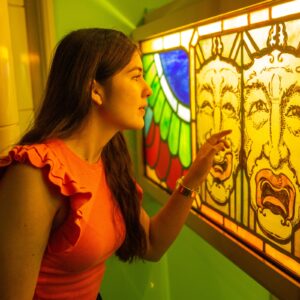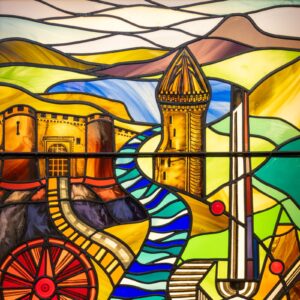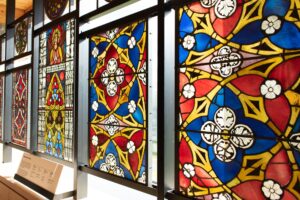Focus On: Inclusion
Each month we’re taking a look at one of the ten priority areas of the new strategy for Scotland’s museums and galleries.
This guide introduces the inclusion priority area, shares relevant resources, and suggests practical steps that your museum or gallery can take to achieve the actions set out in the strategy.

What is inclusion?
Inclusive museums and galleries work with a diverse range of people to support them to tell their stories, creating an environment where all people feel safe, welcome, and engaged.
This is one of the ten priorities of Scotland’s strategy for museums and galleries. You can read the inclusion priority area and actions in full on our website.
All people in Scotland should be able to enjoy and take part in cultural activity. By telling new stories – and by changing the way we tell existing stories – museums and galleries can become more inclusive spaces.
No matter which stage you’re at in your journey towards inclusivity, you’ll be able to make progress by exploring the resources in this guide.
Our 2022 Survey of Scotland’s Museums and Galleries collected information on the different groups that museums and galleries engage with.
Of the museums and galleries that responded, 73% had actively engaged with the health and wellbeing of family groups in the past year.
The groups they had engaged with least were people experiencing racism (25%), people living with chronic pain (21%), and people experiencing homelessness (13%).

Inclusion resources
Our website has lots of useful case studies and advice guides on inclusivity. The following resources are also full of insights and inspiration:
Toolkit: accessible and inclusive tourism
This toolkit by VisitScotland has lots of advice which can help museums to meet the needs of all their visitors.
Toolkit: Open Up
The Association of Independent Museums has created a toolkit to help you think about how to make your museum relevant to people who don’t currently visit. It offers advice on how to increase your visitor numbers, improve your resilience, and better fulfil your organisation’s purpose.
Guidance document: Supporting Decolonisation in Museums
Produced by the Museums Association’s Decolonisation Guidance Working Group, this guide aims to empower more people to take action and lead change as museums address the legacy of British colonialism.
Advice guide: The Museum Test
This test, created by the Changemakers at Our Shared Cultural Heritage, can be used by museums to determine how effectively a gallery or display handles topics of colonialism, empire, slavery, the transatlantic slave trade, and representation.
Factsheet: The Social Model of Disability
This factsheet by Inclusion London introduces the Social Model of Disability and gives an overview of some of its implications, both for Disabled people and for society more generally.
Knowledge Exchange: working with the Roma community
Find out how your museum can engage with the Roma community by watching this Knowledge Exchange and reading the follow-up blog.
Article: Why I think self-defining as ‘Nawken’ will help reduce depression rates…
Nawken (Scottish Traveller) Davie Donaldson writes about cultural trauma and the significance of self-defining as Nawken.
Project: Island Hands Across the Atlantic
Small organisations can make a big impact by focussing on inclusion. Comann Eachdraidh Uibhist a Tuath is collaborating with Barbados Museum and local teenagers to exchange stories, share skills, and build international connections.
Case study: Ellie Diamond’s ‘Denise The Menace’ outfit
Dundee’s McManus championed LGBTQ+ inclusivity with the purchase and display of drag queen Ellie Diamond’s ‘Denise the Menace’ outfit. This case study explores the positive impact this had on visitors and staff alike.
Website: Pronouns.org
This site explains what pronouns are, how they’re used, and why they matter.
Website: New Scots Connect
This digital map by the Scottish Refugee Council allows people who are new to Scotland to search for groups, advice, and support in their area.

Inclusion at your museum or gallery
The following questions were developed by Anti-racist Educator and Advisor Nuzhat Uthmani to help museums and galleries consider inclusivity when planning resources, activities, and projects.
1. Why have you chosen this resource/planned this project?
2. Whose perspective is it from?
3. Whose perspective is missing?
4. Why is it missing?
5. Who does it impact on?
Answering these questions can help you to identify who should be included in the development of your work.
MGS funding
We’ve updated our grants outcomes and expectations to reflect the strategy’s commitment to inclusion.
The museums we fund should be developing their understanding of groups who are underrepresented at their venues, both in the stories they tell and as service users. They should also be seeking to engage and represent those who have previously been excluded.
Visit our funding pages to read our grants outcomes and expectations in full.

Delivering Change
Delivering Change is an MGS project that completed a nine-month development phase, funded by National Lottery Heritage Fund (NLHF), in the spring of 2023.
Our goal is a structural and systemic shift towards a museum sector that is truly inclusive, aiming to support museums from across Scotland to make changes to their organisations and programming to place people at the heart of their work.
Using anti-racism and anti-ableism as guiding principles, this project will acknowledge the multiple oppressions that people face, and the interconnected nature of all justice movements.
Visit our Delivering Change page to find out more and read the reports commissioned for the development of the project.
Find out more
The resources in this guide will help you to make great progress towards the inclusion outcomes of the strategy for Scotland’s museums and galleries. Creating an inclusive museum can also help you meet other strategy priorities such as collaboration, diversity, and education.
Our next focus will be on the collaboration priority area of the strategy. If you have any resources, case studies, or questions relating to either inclusion or collaboration, please get in touch.